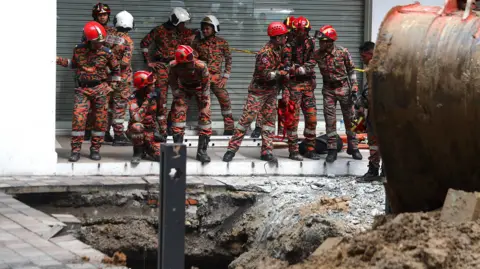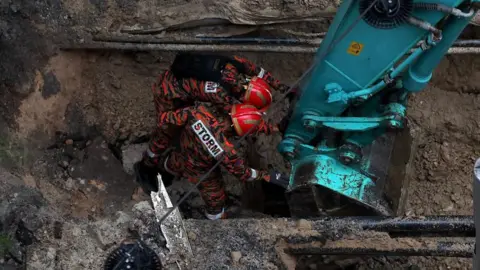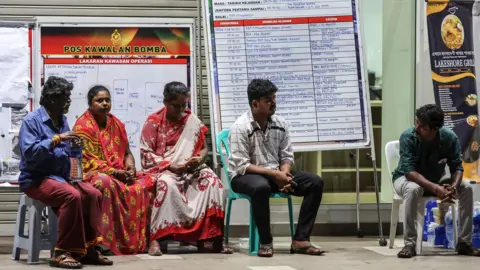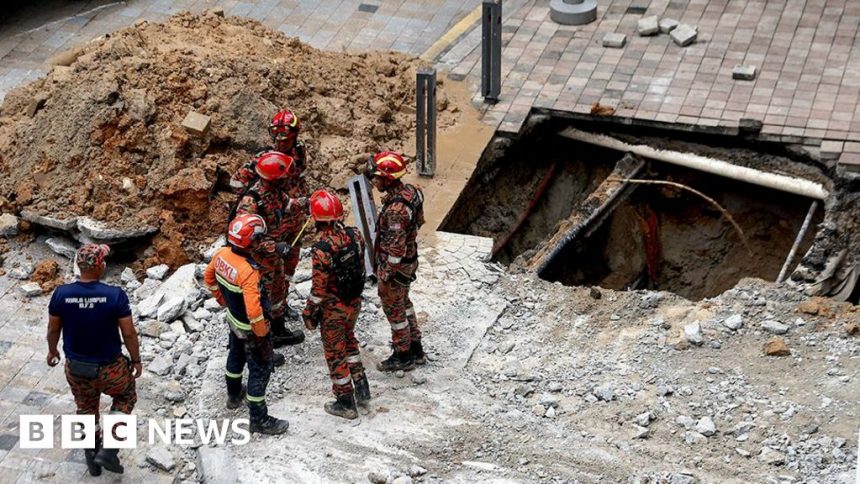Search for woman swallowed by 8m sinkhole now ‘too risky’
 EPA
EPAAn extensive search for an Indian woman who disappeared into a pavement sinkhole in Kuala Lumpur hit a snag on its eighth day, as authorities now say it is “too risky” to continue deploying divers.
The incident has gripped Malaysia, with some 110 rescuers working around the clock this past week in search of Vijaya Lakshmi Gali, 48.
But apart from a pair of slippers found in an initial 17-hour search, their efforts have been unsuccessful.
Two divers who entered via a sewer network at 04:00 local time on Friday (21:00 GMT Thursday) were confronted with strong water currents and hard debris, the Fire and Rescue Department said.
 EPA
EPAThe pair, comprising a firefighter and a sewer worker, also had to “lie flat” as the space was narrow, according to the department’s director-general Nor Hisham Mohammad.
“It was found to be impossible, extremely difficult, to break the solidified [debris] which are like concrete blocks,” he told reporters on Friday.
“Even [when we tried] pulling at them with ropes using up to eight people, [it] was unsuccessful.”
Divers who earlier descended into the sewer in full scuba gear said they had to fight zero visibility and heavy rain.
“When going down into the hole… it was really scary, but this is indeed the duty of a firefighter; we have to overcome the fear and surrender to God,” firefighter Alimaddia Bukri told local newspaper Simar Harian earlier this week.
“It is pitch black in that pipe,” another diver told The Straits Times on Wednesday.
“You don’t want to know what’s in there. It’s full of human waste and other garbage. We decontaminate immediately after each dive.”
 EPA
EPAMs Gali, who was visiting from India’s Andhra Pradesh state, was reportedly heading towards a nearby temple with her family when she was swallowed by the 8m (26ft) deep sinkhole on the street of Jalan Masjid India.
Excavators were deployed shortly after the incident to dig up the area around the sinkhole, while rescuers used sniffer dogs and crawler cameras – robotic cameras used to inspect pipes – to get a better sense of what was happening underground.
They have also tried to break apart hardened debris using high-pressure water jets, iron hooks and rope.
On Tuesday, officials wheeled a ground-penetrating radar device onto the site, to help them pinpoint changes in material density underground.
The next day, a second sinkhole appeared just 50m from the first one. A Malaysian geologist, speaking to local newspaper Malaysiakini, attributed it to the ongoing search and rescue operation.
Search efforts in the last few days have focused on clearing a 15m blockage in the sewer lines below Wisma Yakin, an office building about 44m from the first sinkhole.
Reports said the blockage was made of human waste, tyres, hair and solidified used cooking oil, among other things.
Some parts of Jalan Masjid India have been cordoned off as the search continues.
The area, normally popular with tourists, has become unusually quiet in the last few days. Traders have experienced a 50% to 70% drop in sales, with some considering closures to cut their losses, according to local reports.
The Malaysian government has extended the visas for Ms Gali’s family for a month while they await news of her whereabouts. They were due to return to India last Saturday.
Kuala Lumpur’s City Hall has also cancelled National Day celebrations out of respect for the family.
The incident has sparked fear and anger among Malaysians, many of whom are questioning what might have caused the sinkhole.
Authorities said they would carry out an “integrity audit” to determine the cause. An official from the Minerals and Geosciences Department said initial observations suggested it could have been due to a combination of human activities and climate change.
Additional reporting by Gavin Butler in Singapore







